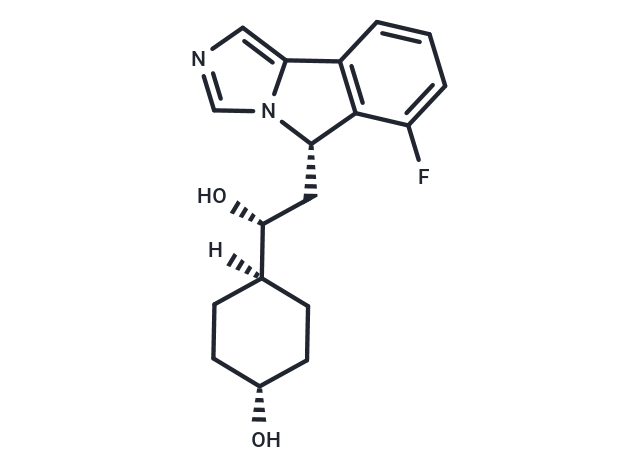Shopping Cart
Remove All Your shopping cart is currently empty
Your shopping cart is currently empty
Navoximod (GDC-0919) (NLG- 919, GDC-0919) is a potent indoleamine-(2,3)-dioxygenase (IDO) pathway inhibitor (Ki/EC50: 7 nM/75 nM).

| Pack Size | Price | USA Warehouse | Global Warehouse | Quantity |
|---|---|---|---|---|
| 1 mg | $162 | In Stock | In Stock | |
| 5 mg | $347 | In Stock | In Stock | |
| 10 mg | $522 | In Stock | In Stock | |
| 25 mg | $667 | In Stock | In Stock | |
| 50 mg | $828 | In Stock | In Stock | |
| 100 mg | $1,160 | - | In Stock | |
| 1 mL x 10 mM (in DMSO) | $353 | In Stock | In Stock |
| Description | Navoximod (GDC-0919) (NLG- 919, GDC-0919) is a potent indoleamine-(2,3)-dioxygenase (IDO) pathway inhibitor (Ki/EC50: 7 nM/75 nM). |
| Targets&IC50 | IDO:7 nM (Ki), IDO:75 nM (EC50) |
| In vitro | Navoximod potently blocks IDO-induced T cell suppression and restores robust T cell responses (ED50: 80 nM) using IDO-expressing human and mouse dendritic cells (DCs) in allogeneic mixed lymphocyte reaction (MLR) and in vitro models from tumor-draining lymph nodes (ED50: 120 nM) [1]. It inhibits IDO activity in a concentration-dependent manner (EC50: 0.95 μM). PEG2k-Fmoc-NLG(L) is less active (EC50: 3.4 μM) compared to Navoximod, while PEG2k-Fmoc-NLG(S) is the least active (EC50>10 μM). Coculture of IDO+ tumor cells with BALB/c mouse splenocytes shows significant inhibition of T-cell proliferation, which is attenuated by Navoximod. PEG2k-Fmoc-NLG(L) also reverses the inhibitory effect of tumor cells, albeit slightly less potently than Navoximod [3]. |
| In vivo | In mice, a single oral administration of Navoximod reduces the concentration of plasma and tissue Kyn by ~50%. In vivo, in mice bearing large established B16F10 tumors, administration of Navoximod markedly enhances the anti-tumor responses of na?ve, resting pmel-1 cells to vaccination with cognate hgp100 peptide plus CpG-1826 in IFA. In this stringent established-tumor model, Navoximod plus pmel-1/vaccine produces a dramatic collapse of tumor size within 4 days of vaccination (~95% reduction in tumor volume compared to control animals receiving pmel-1/vaccine alone without Navoximod) [1]. When combined with Temozolomide (TMZ)+radiation therapy (RT), both Navoximod and 1-methyl-D-tryptophan (D-1MT, indoximod) enhance survival relative to mice treated with TMZ+RT alone [2]. |
| Cell Research | Briefly, HeLa cells are seeded in a 96-well plate at a cell density of 5000 cells per well and allowed to grow overnight. Recombinant human IFN-γ is then added to each well with a final concentration of 50?ng/mL. At the same time, various concentrations of PEG2k-Fmoc-NLG(L), PEG2k-Fmoc-NLG(S) or Navoximod (NLG919) (50?nM-20?μM) are added to the cells. After 48?h of incubation, 150?μL of the supernatants per well is transferred to a new 96-well plate. Seventy-five μL of 30% trichloroacetic acid is added into each well and the mixture is incubated at 50°C for 30?min to hydrolyse N-formylkynurenine to kynurenine. For the colorimetric assay, supernatants are transferred to a new 96-well plate, mixed with an equal volume of Ehrlich reagent (2% p-dimethylamino-benzaldehyde w/v in glacial acetic acid), and incubated for 10?min at RT. The reaction product is measured at 490?nm by a plate reader [3]. |
| Animal Research | Mice are anesthetized with 4% isoflurane, and the surgical plane of anesthesia is maintained with 2% isoflurane in oxygen. Mice are immobilized in a stereotactic frame for tumor implantation. Briefly, the skull is shaved and exposed with a 0.5 cm skin incision. With the antiseptic technique, 10^5 GL261 cells (suspended in 3 μL RPMI-1640) are injected at the following coordinates with respect to the bregma on the right side (antero-posterior, -2 mm; medio-lateral, 2 mm; dorsoventral, 3 mm). This placement reproducibly yielded tumor growth in a paracortical area of the posterolateral right frontal lobe. Tumor-bearing mice are treated with combinations of oral DL-1MT (2 mg/mL D-1MT mixed with 2 mg/mL L-1MT) in drinking water, D-1MT (4 mg/mL) in drinking water, Navoximod (6 mg/mL) in drinking water, intraperitoneal cyclophosphamide, intraperitoneal temozolomide, and/or total-body radiation (500 cGy from a 137Cs source), as detailed in figure legends. Mice are observed daily and sacrificed when they became ill or moribund [2]. |
| Synonyms | NLG-919, GDC-0919 |
| Molecular Weight | 316.37 |
| Formula | C18H21FN2O2 |
| Cas No. | 1402837-78-8 |
| Smiles | [H][C@@]1(CC[C@H](O)CC1)[C@H](O)C[C@H]1c2c(cccc2F)-c2cncn12 |
| Relative Density. | 1.42 g/cm3 (Predicted) |
| Color | White |
| Appearance | Solid |
| Storage | Powder: -20°C for 3 years | In solvent: -80°C for 1 year | Shipping with blue ice/Shipping at ambient temperature. | |||||||||||||||||||||||||||||||||||
| Solubility Information | DMSO: 100 mg/mL (316.09 mM), Sonication is recommended. | |||||||||||||||||||||||||||||||||||
| In Vivo Formulation | 10% DMSO+40% PEG300+5% Tween 80+45% Saline: 4 mg/mL (12.64 mM), Sonication is recommended. Please add the solvents sequentially, clarifying the solution as much as possible before adding the next one. Dissolve by heating and/or sonication if necessary. Working solution is recommended to be prepared and used immediately. The formulation provided above is for reference purposes only. In vivo formulations may vary and should be modified based on specific experimental conditions. | |||||||||||||||||||||||||||||||||||
Solution Preparation Table | ||||||||||||||||||||||||||||||||||||
DMSO
| ||||||||||||||||||||||||||||||||||||
| Size | Quantity | Unit Price | Amount | Operation |
|---|

Copyright © 2015-2025 TargetMol Chemicals Inc. All Rights Reserved.